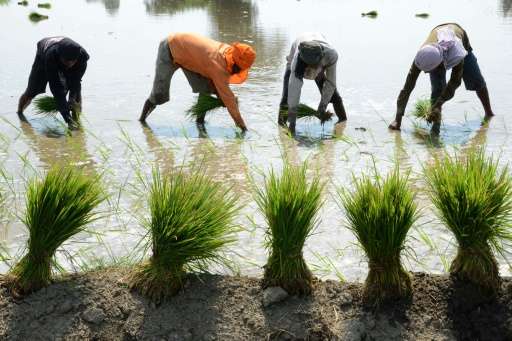Scientists create low-methane rice

Scientists said Wednesday they had created a rice variety with starchier grains that emits less methane, a step towards the twin goals of feeding more people and curbing global warming.
The cultivation of rice, a staple starch for billions of people, is also mankind's major emitter of methane, a potent climate-altering gas.
Methane lives for a shorter time in the atmosphere than carbon dioxide (CO2), the most abundant greenhouse gas, but traps far more heat radiated from Earth's surface.
Every year, rice paddies pump out 25 to 100 million tonnes of methane—the second-most important greenhouse gas at about 16 percent.
This means a high risk for the planet as rice cultivation expands to feed a growing population, said the paper, published in the journal Nature.
"There is an urgent need to establish sustainable technologies for increasing rice production while reducing methane fluxes from rice paddies," wrote the team led by Chuanxin Sun of the Swedish University of Agricultural Sciences.
Already in 2002, scientists reported that the more grain carried by rice plants, the less methane they emitted.
The leaves and stems of rice plants take up CO2, which is transformed through photosynthesis into sugars that are used to produce starch in the shoots, roots and grains.

Carbon released from dead plants, or directly into the soil via the roots, is transformed by microorganisms into methane, which can escape into the atmosphere.
Larger, starchier rice grains mean there is less carbon transferred to the soil to be turned into methane.
But attempts to reduce emissions from paddies have focused on changes in farming practices, which can be onerous and expensive.
'Groundbreaking' work
Tackling the problem differently, a team from China, the United States and Sweden added a barley gene to a conventional rice cultivar to create a variety dubbed SUSIBA2.
"Three-year field trials in China demonstrated that the cultivation of SUSIBA2 rice was associated with a significant reduction in methane emissions," said the study.
"SUSIBA2 rice offers a sustainable means of providing increased starch content for food production while reducing greenhouse gas emissions from rice cultivation."
In a comment also carried by Nature, Paul Bodelier of the Netherlands Institute of Ecology described the research as "groundbreaking", but cautioned it also raised several "biological and ethics concerns".
"In addition to the general questions surrounding the use of genetically modified crops for human consumption, and how access to seed for such crops is controlled, we do not yet have a clear picture of how this modification affects rice plants' survival and general function," said Bodelier.
Long-term measurements of methane emissions would be needed to calculate the crop's potential overall impact on greenhouse gas reduction efforts, he wrote.
Also, the reduction of carbon in soil may have unknown consequences for other types of microorganisms that could aid or harm the plants.
All said, the work should spur scientists worldwide "to conduct experiments to verify whether this variety will enable more sustainable cultivation of the crop that feeds half the human population," said Bodelier.
More information: Nature DOI: 10.1038/nature14673
Journal information: Nature
© 2015 AFP


















